TORONTO (May 4) — For more than two months, all signs have pointed toward a rebirth of the oldest rivalry in the National Hockey League. A best–of–seven clash in the opening round of the Stanley Cup tournament between the Toronto Maple Leafs and Montreal Canadiens — first and fourth–place qualifiers in the North Division. But, the Winnipeg Jets are enacting the role of party pooper. More spectacularly than anyone could have envisioned.
At one point challenging the Leafs for top spot in the all–Canadian sector, the Jets have pulled a “Brian Burke.” Their version of the “18–wheeler” will not result in losing a playoff spot, but Paul Maurice’s crew — having dropped seven consecutive games — is now deadlocked with Montreal for third place (57 points); Winnipeg maintaining the edge, at the moment, with a 27–25 lead in victories. The Canadiens, meanwhile, have won three in a row, including last night’s comeback–from–the–dead against the Leafs at the Bell Centre. It appeared as if Montreal would lose in regulation time. But, Phillip Danault scored at 19:08 of the third period and rookie Cole Caufield beat Jack Campbell with 17 seconds left in overtime for a 3–2 win… and two monster points. It is largely incumbent upon the Leafs to craft the long–awaited playoff meeting with Montreal. By defeating the Habs in their two remaining matches: Thursday and Saturday nights at Scotiabank Arena. If the Canadiens stay hot, and the Jets ice–cold, Toronto and Winnipeg will almost surely clash in the opening round, leaving second–place Edmonton to deal with Montreal. The Maple Leafs and Canadiens have not hooked up in the Stanley Cup tournament since the 1979 quarterfinals — a four–game Montreal sweep en route to a fourth consecutive NHL title under Scotty Bowman.
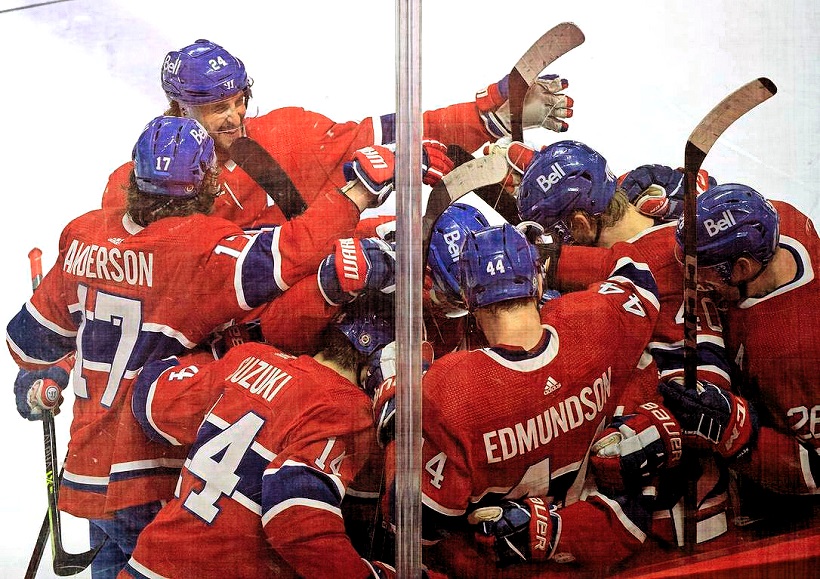
THE MONTREAL CANADIENS CELEBRATE AT THE BELL CENTRE AFTER COMING BACK TO DEFEAT THE TORONTO MAPLE LEAFS, 3–2, IN OVERTIME ON MONDAY NIGHT. GETTY IMAGES/NHL/TORONTO STAR
For my money — and as I’ve previously articulated — the Leafs and Habs avoiding one another in this playoff year would be a blessing. Though fans in either city probably don’t care, I maintain it would be a considerable shame if the first Stanley Cup round between the clubs in 42 years were contested in empty arenas. The flip–side, of course, is the NHL perhaps returning to its conventional structure for next season, thereby annulling the all–Canadian division and restricting the opportunity for a Toronto–Montreal playoff quarrel. Still, I would accept that as a more–preferable option to Scotiabank Arena and the Bell Centre being devoid of the playoff environment that only a live audience can engender. To be honest, I have not enjoyed watching professional sport during the pandemic. I suppose that competing in vacated arenas and stadia is preferable to there being no sports at all. But, I think we’ve noticed — by its absence — the inherent need for the action to be surrounded with a mass of humanity. Home–ice advantage, even with last line–change, becomes nearly obsolete in an empty hockey arena. And, television, despite an honest effort, cannot, in any way, duplicate the atmosphere of 18,000 rabid spectators.
It’s the same reason that I contend the media is providing a disservice by extrapolating the events of this season. I’ve done it, myself — projecting, for example, how many points the Leafs would accumulate in a normal, 82–game schedule. Overlooking, of course, that Toronto has not encountered any of the other top clubs in the league (save for Edmonton) during the 56–game exercise. Would the Leafs be sitting at 33–13–6 while playing amid the Atlantic Division with Tampa Bay, Florida and Boston? And, while occasionally brushing up against Carolina, Washington, Pittsburgh, the Islanders, Vegas or Colorado? The answer isn’t even “maybe”; it’s a flat “no.” Neither would Auston Matthews likely be running away with the NHL goal–scoring lead, even if No. 34 winning the Rocket Richard Trophy would be unsurprising in any setup. So, this season isn’t as authentic or legitimate as most before it. In modern NHL history, the credibility of the two 48–game schedules — those which occurred after labor disruptions between October and January in 1994–95 and 2012–13 — can also be questioned. Though the Stanley Cup winners of ’95 and ’13 (New Jersey and Chicago) reflect appropriately, given they were multiple–time champions.
ANATOMY OF A BAD SCOOP: I blame no one but myself for an amateurish, inexcusable mistake on Monday night, posting (on Facebook and Twitter) that former Leafs defenseman Mike Pelyk (1967–68 to 1977–78) had died last Friday after a long illness. Nothing is worse, from a journalistic perspective, than botching a death. And, it’s all on me for doing so. In this case, and while mortified, I was at least happy to be wrong. Here’s what happened: Just after the supper hour, I received an email from a prominent former broadcaster of Leafs games telling me of the “news.” I replied to the person, asking if this was “100 percent accurate” and was told that Leafs legend Dave Keon had relayed the information… and that a death notice would be appearing in today’s edition of the Globe and Mail. Given the former broadcaster’s prominence — and Keon’s obvious standing in Maple Leafs lore — I felt confident in posting the sad message. Less than 20 minutes later, however, came a pair of alarming emails from the ex–play caller: “Hold off!!!” Then… “Wrong!!!” Turns out that Keon had been told of a former hockey player named Mike Elik passing away and had evidently misinterpreted the name. And, even that, I am getting second–hand, from the broadcaster. Still, I take full and unequivocal responsibility for my screw–up. I was in the media business more than long enough to know better. NEVER post a death until confirmed. No one from the Pelyk family has indicated they saw the premature notice. But, I profusely apologize to anyone that may have. And, of course, to Mike — a good person I came to know in my years covering the Leafs for The FAN–590.
NEWSPAPER FRONTS
From my collection — Part 1
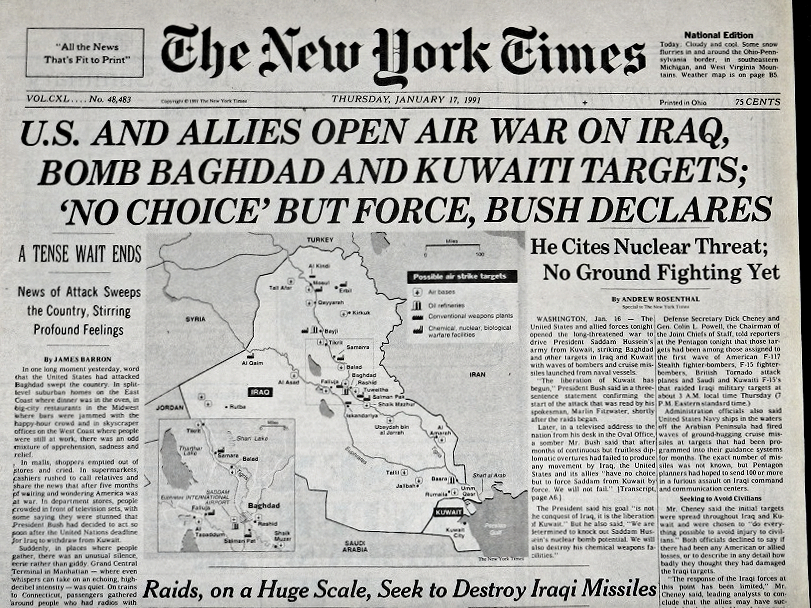
It’s hard to fathom that more than 30 years have passed since U.S. president George Bush launched the Desert Storm assault on Iraq, for its invasion of oil–rich Kuwait. Who of vintage can forget being glued to their TV’s throughout the night of Jan. 16, 1991 as a CNN crew relayed first–hand, visual accounts of the bombing from a hotel balcony in Baghdad? The Gulf War, as it was called, lasted for roughly a month before allied troops overpowered the National Guard of Iraqi dictator Saddam Hussein. Early in the conflict, Hussein lobbed scud missiles into Israel, trying to fracture the coalition of nations backing the U.S. effort. The Israeli government showed remarkable restraint and Hussein was ultimately toppled. He was captured hiding in a manhole by the U.S. and executed in December 2006. I still have the newspapers, above and below, from the day after the Gulf War began.
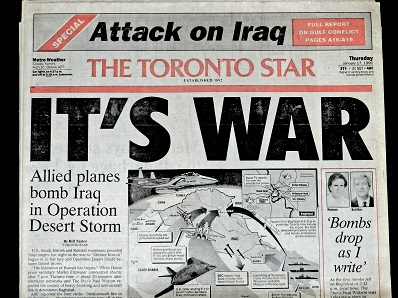
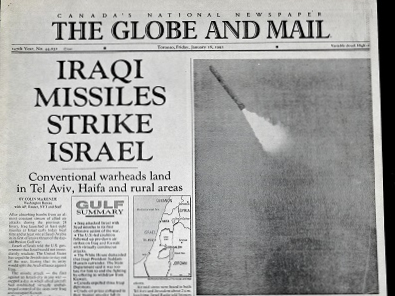
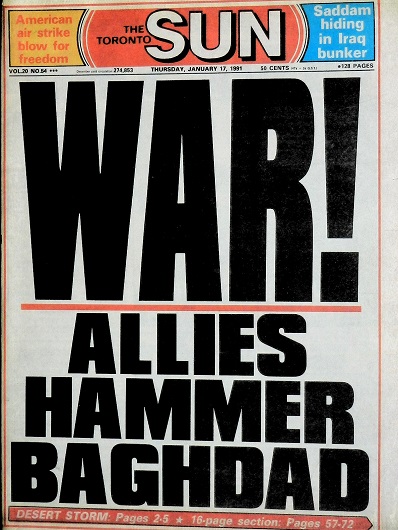
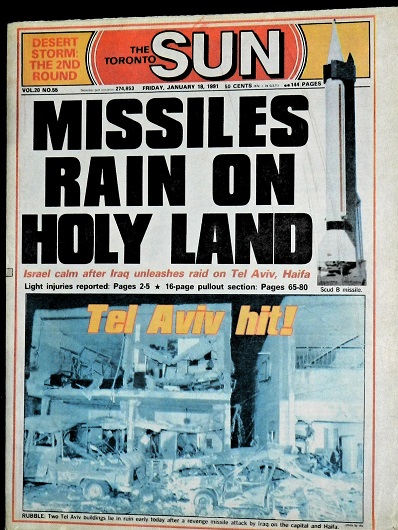
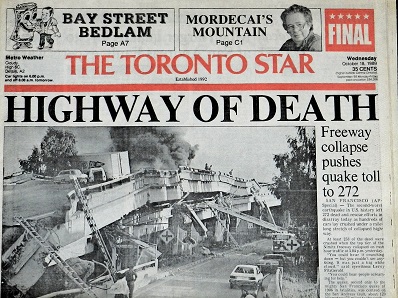
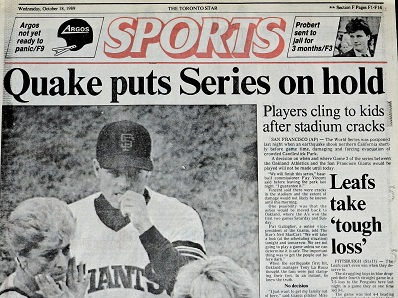
Another long night spent in front of the TV was Oct. 17, 1989 when the Loma Prieta earthquake devastated the San Francisco Bay Area just prior to Game 3 of the World Series, at Candlestick Park, between the Giants and Oakland A’s (above and below). For more than three hours, ABC voice Al Michaels, a long–time resident of the Bay Area, narrated aerial images of the quake aftermath. The 6.9–magnitude tremor struck at 5:04 p.m., local time, as freeways were jammed with motorists heading home from work. It resulted in 63 deaths and 3,757 injuries. Forty–two people died in Oakland when an upper–strand portion of Interstate–880 (the Nimitz Freeway) pancaked onto the lower strand. A smaller portion of the San Francisco–Oakland Bay Bridge caved in. Initial reports of 250 deaths were inaccurate. After ten days, the World Series resumed. The A’s swept the Giants in four.
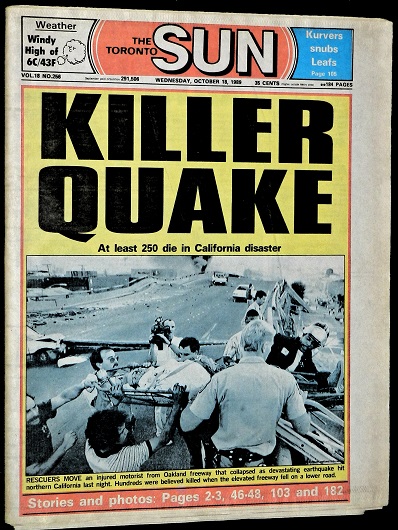
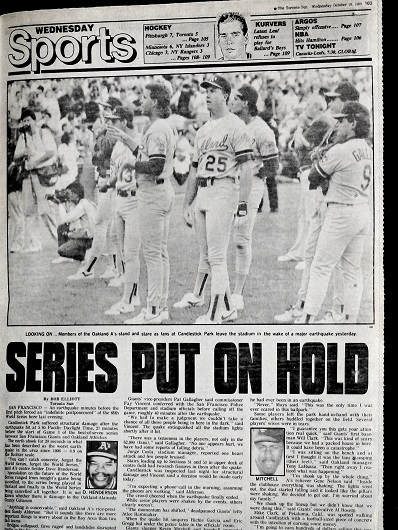
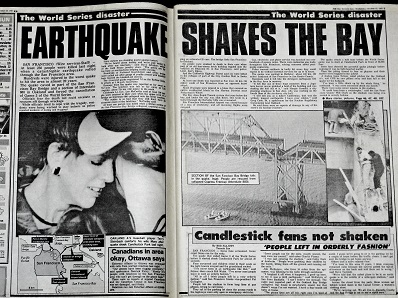
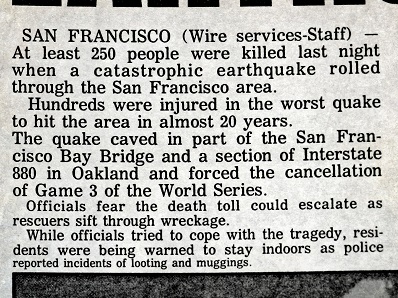
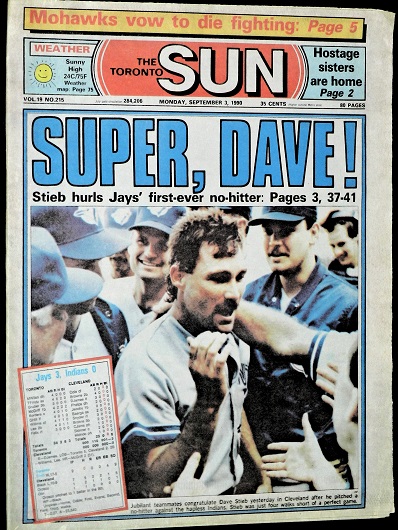
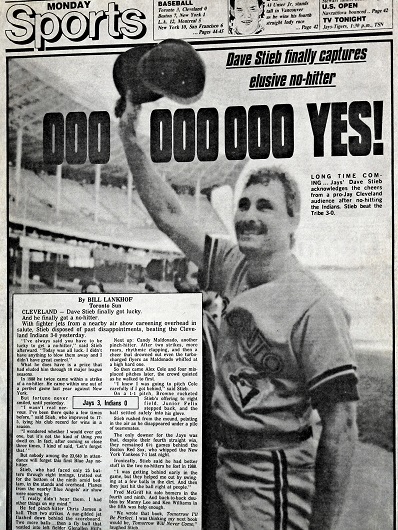
He is the best home–grown pitcher in Blue Jays history… and still the only one to toss a no–hitter (above and below). Dave Stieb blanked the Cleveland Indians at the old Municipal Stadium on Sep. 2, 1990. On three prior occasions, he had flirted with no–hitters, only to lose them in the ninth inning — and with astonishingly bad luck. It prompted Stieb to write an autobiography entitled TOMORROW I’LL BE PERFECT. As we walked off the field in Cleveland, he waved to co–author, Kevin Boland, seated in the press box. Stieb was the Blue Jays’ first superstar. He started for the American League in consecutive All Star games: 1983 (Comiskey Park, Chicago) and 1984 (Candlestick Park, San Francisco). Stieb won 175 games for the Blue Jays, including a career–best 18 in 1990.
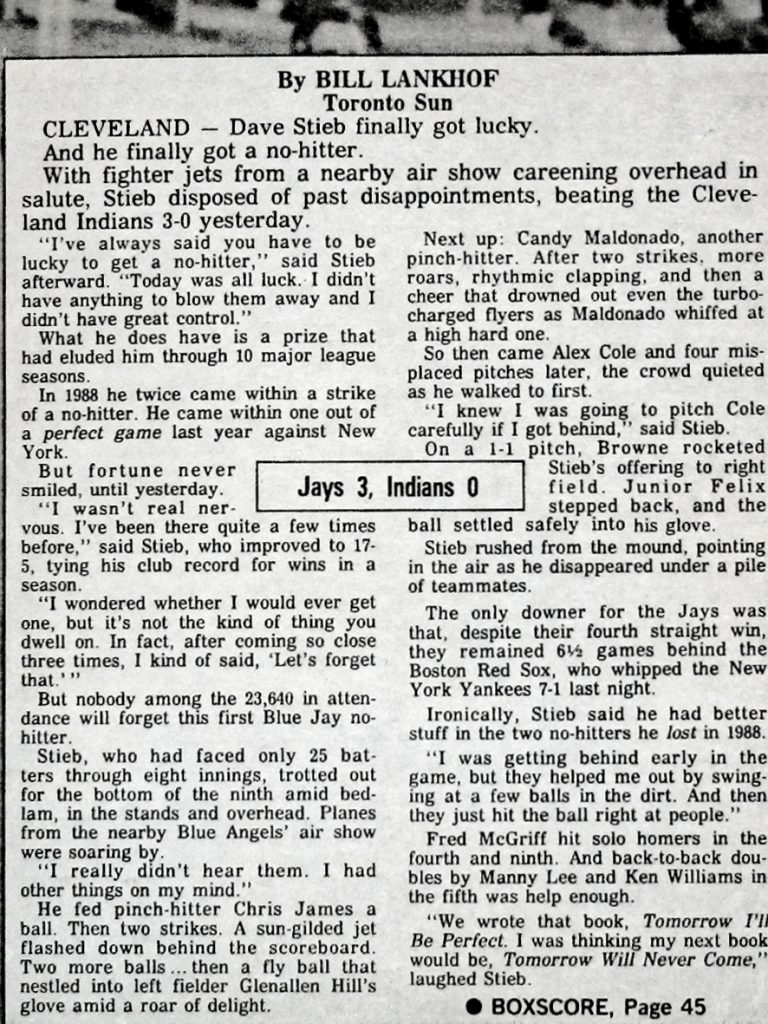
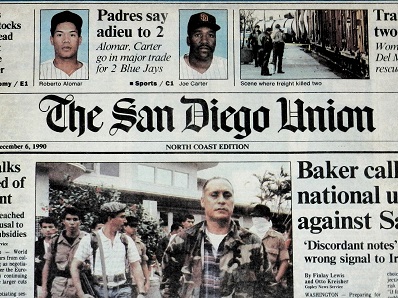
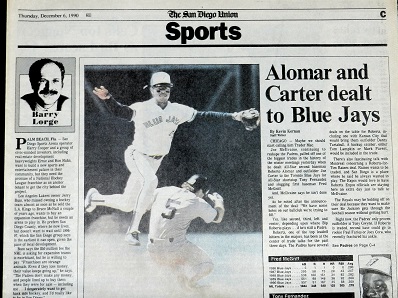
Roberto Alomar made news last week when Major League Baseball — and the Toronto Blue Jays — severed ties with the Hall–of–Fame second baseman for alleged sexual misconduct dating to 2014. Alomar was traded to Toronto from San Diego (above) on Dec. 5, 1990, at the Baseball Winter Meetings in Chicago. In a blockbuster move, Joe Carter accompanied Alomar to the Blue Jays for first–baseman Fred McGriff and shortstop Tony Fernandez. As mentioned in all corners last week, Alomar’s two–run homer off Dennis Eckersley of Oakland in Game 4 of the 1992 American League Championship Series remains the most–significant moment in franchise history. If not for the game–tying belt in the ninth inning at the Oakland Coliseum, the Blue Jays wouldn’t likely have advanced to play (and defeat) the Atlanta Braves in the ’92 World Series. Carter followed in ’93 with his “…touch ’em all, Joe!” home run in Game 6 against Philadelphia, at the SkyDome (now Rogers Centre).
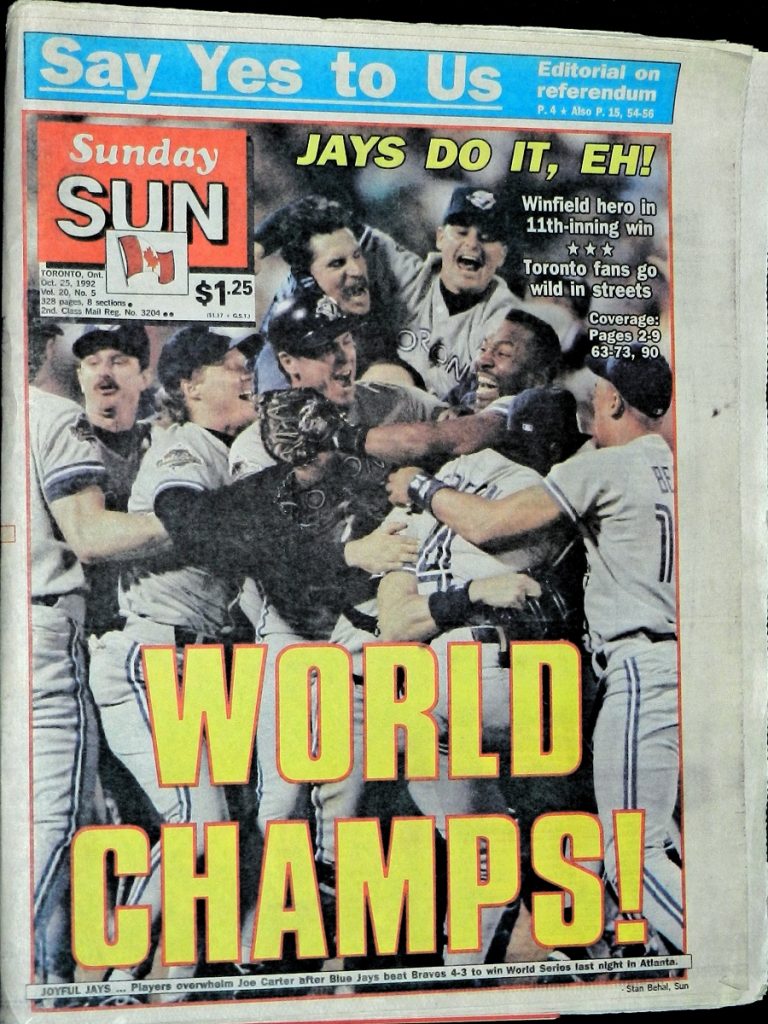
Full edition of the Sunday Toronto Sun on Oct. 25, 1992 — the morning after the Blue Jays became the first team from outside the United States to win the World Series. I had the privilege of covering Game 6 of the ’92 Series at the old Atlanta Fulton–County Stadium for The FAN–1430… standing in the visitors’ radio booth, for the final out, behind the late Tom Cheek and broadcast partner Jerry Howarth. What a memory!
EMAIL: HOWARDLBERGER@GMAIL.COM

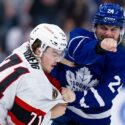
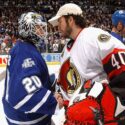





























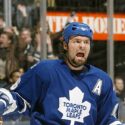
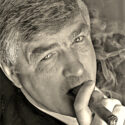
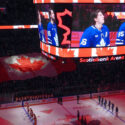

Re: Mike Pelyk. I was fortunate to get to know him a bit….great guy. Howard, every human makes mistakes. I’m sure Mike is just happy to be alive. No worries.